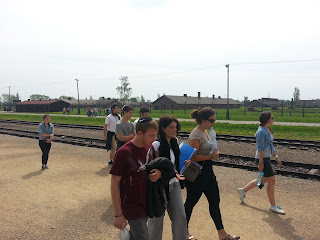Today we began our second half of the trip, visiting the concentration and death camps. We started off with Birkenau. As we walked up the path to the gate where millions walked through, never to come out again, we all quietly contemplated what happened in the place which we have learnt so much about in books, yet now stood in real life.
We entered the camp and went to the bunkers where they housed hundreds of humans in a stable that was built in with the purpose and size for 52 horses. This was the first of many shocks that overcame us as it is impossible to understand how people could be subjected to living like this. Moving to the toilet block, where there were about 200 holes in the ground for people to use, and only had a roof above it since when it was open, the smell was discomforting to the Nazis. Once again we were reminded of the perverse upside down reality of the camps, since despite the conditions in that room, it was a favourite place to gather for those there as it was a chance to ‘get away’ from the Nazis, as they wouldn’t think of going in there.
After that, we sat down to listen to Tamar give an account of her grandfather’s life during the war and the values and lessons that she learnt from him. Then Arielle told us about her great aunt and what she went through and how she survived.
We then walked to the gas chambers and crematoriums. We tried and utterly failed to imagine how many Jews passed down those stairs to their deaths and what they were possibly thinking in their final moments. Zoe related the story of how the Jews who worked in the crematoriums managed to blow one up towards the end of the war, but unfortunately, it was too little too late for many. We said a yizkor prayer for all those who perished there before slowly making our way back to the bus.
The bus then drove us to Auschwitz 1, which was on total contrast to Birkenau and looked like an outdoor museum with thousands of people pouring though. We passed through the famous gate, ‘Works sets free’, before beginning our tour. What we immediately observed was how beautiful it looked, even like a Hollywood set. It wasn’t as grim or desolate as Birkenau and many of the buildings were standing, row upon row. Only when entering them and hearing the stories of what occurred did we become attuned to the horrors that once occurred here.
We passed into each of the buildings, seeing exhibits and different items and artefacts. The most haunting were the rooms containing just one item, thousands of times over. There was a room full of hair, ready to be sold to factories to be made into tablecloths. There was a room full of suitcases, complete with names and birthdays of their owners, waiting to be picked up. There was a room full of shoes, never to be worn again. There was a room full of crockery, marked by blue and red, distinguishing the dairy from the meat.
The final building we entered was the prison cells, a prison inside a prison. We saw the different cells and what each was used for. As hard as it was to comprehend the living conditions of the ‘normal’ prisoners, it was even more difficult to understand how anyone could survive more than a day in these cells. Not many did.
Finally, we came to the crematorium, situated across the road from the pub where the Nazis enjoyed their downtime. We slowly walked through it, seeing the way it was set up, in order to most efficiently murder and cremate as many people in as little time as possible.
We finished off our day with a tekes, remembering all those who perished in these camps. As one, we sang the Hatikvah on the site where many retained hope to the last and who, if there was a Jewish State for them, may have survived.
On the bus ride to dinner, we watched ‘Fiddler on the roof’ to get a sense of what shtetl life was like and how Jews lived in those times. It was also a chance to relieve ourselves emotionally from the taxing day we had just experienced. After dinner, we made our way to Lublin.
Dion





















No comments:
Post a Comment